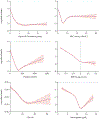Predicting mortality within 1 year of ART initiation in children and adolescents living with HIV in sub-Saharan Africa: a retrospective observational cohort study
- PMID: 38762295
- PMCID: PMC11149103
- DOI: 10.1016/S2214-109X(24)00091-3
Predicting mortality within 1 year of ART initiation in children and adolescents living with HIV in sub-Saharan Africa: a retrospective observational cohort study
Abstract
Background: Differentiated service delivery (DSD) for children and adolescents living with HIV can improve targeted resource use. We derived a mortality prediction score to guide clinical decision making for children and adolescents living with HIV.
Methods: Data for this retrospective observational cohort study were evaluated for all children and adolescents living with HIV and initiating antiretroviral therapy (ART); aged 0-19 years; and enrolled at Baylor clinics in Eswatini, Malawi, Lesotho, Tanzania, and Uganda between 2005 and 2020. Data for clinical prediction, including anthropometric values, physical examination, ART, WHO stage, and laboratory tests were captured at ART initiation. Backward stepwise variable selection and logistic regression were performed to develop predictive models for mortality within 1 year of ART initiation. Probabilities of mortality were generated, compared with true outcomes, internally validated, and evaluated against WHO advanced HIV criteria.
Findings: The study population included 16 958 children and adolescents living with HIV and initiated on ART between May 18, 2005, and Dec 18, 2020. Predictive variables for the most accurate model included: age, CD4 percentage, white blood cell count, haemoglobin concentration, platelet count, and BMI Z score as continuous variables, and WHO clinical stage and oedema, abnormal muscle tone and respiratory distress on examination as categorical variables. The area under the curve (AUC) of the predictive model was 0·851 (95% CI 0·839-0·863) in the training set and 0·822 (0·800-0·845) in the test set, compared with 0·606 (0·595-0·617) for the WHO advanced HIV criteria (p<0·0001).
Interpretation: This study evaluated a large, multinational population to derive a mortality prediction tool for children and adolescents living with HIV. The model more accurately predicted clinical outcomes than the WHO advanced HIV criteria and has the potential to improve DSD for children and adolescents living with HIV in high-burden settings.
Funding: National Institute of Health Fogarty International Center.
Copyright © 2024 The Author(s). Published by Elsevier Ltd. This is an Open Access article under the CC BY-NC-ND 4.0 license. Published by Elsevier Ltd.. All rights reserved.
Conflict of interest statement
Declaration of interests We declare no competing interests.
Figures



Similar articles
-
Variations in the characteristics and outcomes of children living with HIV following universal ART in sub-Saharan Africa (2006-17): a retrospective cohort study.Lancet HIV. 2021 Jun;8(6):e353-e362. doi: 10.1016/S2352-3018(21)00004-7. Epub 2021 Apr 28. Lancet HIV. 2021. PMID: 33932330 Free PMC article.
-
Time-varying age- and CD4-stratified rates of mortality and WHO stage 3 and stage 4 events in children, adolescents and youth 0 to 24 years living with perinatally acquired HIV, before and after antiretroviral therapy initiation in the paediatric IeDEA Global Cohort Consortium.J Int AIDS Soc. 2020 Oct;23(10):e25617. doi: 10.1002/jia2.25617. J Int AIDS Soc. 2020. PMID: 33034417 Free PMC article.
-
Contemporary issues on the epidemiology and antiretroviral adherence of HIV-infected adolescents in sub-Saharan Africa: a narrative review.J Int AIDS Soc. 2015 Sep 16;18(1):20049. doi: 10.7448/IAS.18.1.20049. eCollection 2015. J Int AIDS Soc. 2015. PMID: 26385853 Free PMC article. Review.
-
Predictors of dropout from care among HIV-infected patients initiating antiretroviral therapy at a public sector HIV treatment clinic in sub-Saharan Africa.BMC Infect Dis. 2016 Feb 1;16:43. doi: 10.1186/s12879-016-1392-7. BMC Infect Dis. 2016. PMID: 26832737 Free PMC article.
-
Retention in care of HIV-infected children from HIV test to start of antiretroviral therapy: systematic review.PLoS One. 2013;8(2):e56446. doi: 10.1371/journal.pone.0056446. Epub 2013 Feb 20. PLoS One. 2013. PMID: 23437135 Free PMC article.
Cited by
-
Development with external validation of a prediction model for postoperative acute kidney injury following noncardiac surgery in elderly patients.BMC Geriatr. 2025 May 30;25(1):390. doi: 10.1186/s12877-025-06023-3. BMC Geriatr. 2025. PMID: 40447991 Free PMC article.
References
-
- Bacha JM, Aririguzo LC, Mng’ong’o V, et al. The Standardized Pediatric Expedited Encounters for ART Drugs Initiative (SPEEDI): description and evaluation of an innovative pediatric, adolescent, and young adult antiretroviral service delivery model in Tanzania. BMC Infect Dis 2018; 18: 1–9. - PMC - PubMed
-
- UNAIDS. UNAIDS Global HIV & AIDS Statistics. https://www.unaids.org/en/resources/fact-sheet#:~:text=38·0%20million%20... (accessed July 29, 2020).
Publication types
MeSH terms
Grants and funding
LinkOut - more resources
Full Text Sources
Medical
Research Materials

